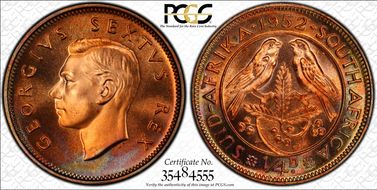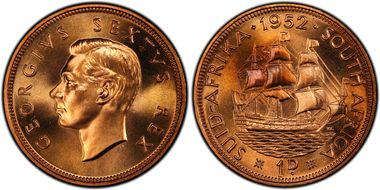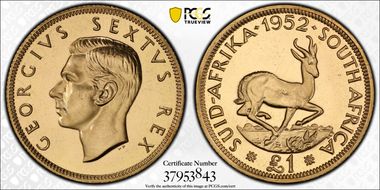SWvdM 的钱币相册
*1937* King George VI was crowned in 1937 and his likeness replaced King George V on all coinage of the British Empire. He faces left and although it is custom that each new monarch faces the opposite way of the previous monarch, the abdication of Edward VIII, after a short reign, resulted in King George VI facing the same way as King George V. There were no coins struck for King Edward VIII in South Africa (some patterns exist). The obverse design: head of King George VI. Inscription: GEORGIVS VI REX IMPERATOR. Designed by Henry Paget (HP). The reverse design: A circle containing two sparrows, facing each other, sitting on a branch of a Mimosa tree. Inscription: SOUTH AFRICA to the left and SUID-AFRIKA to the right of the coin. The date top center and the denomination "1/4D." bottom center. Designed by Kruger Gray (KG). *1948* A design change was made to the obverse of the coin. The inscription was changed to GEORGIVS SEXTUS REX. With the independence of India in 1948, Great Britain was no longer regarded an empire and thus the removal of the word "IMPERATOR". *1951* A design change was made to the reverse of the coin. The Afrikaans "SUID-AFRIKA" moved to the left of the coin and "SOUTH AFRICA" to the right. The fonts were changed for all text.
*1937* King George VI was crowned in 1937 and his likeness replaced King George V on all coinage of the British Empire. He faces left and although it is custom that each new monarch faces the opposite way of the previous monarch, the abdication of Edward VIII, after a short reign, resulted in King George VI facing the same way as King George V. There were no coins struck for King Edward VIII in South Africa (some patterns exist). The obverse design: head of King George VI. Inscription: GEORGIVS VI REX IMPERATOR. Designed by Henry Paget (HP). The reverse design: A VOC (Vereenigde Oost-Indische Compagnie) ship in full sail (probably the Drommedaris - see description under 5 Shilling coin). Surrounding Inscription: To the left: “SOUTH AFRICA”, to the right “SUID-AFRIKA” with the date at the top center and “½D.” at the bottom center. Reverse design artist: Kruger Gray (KG above water to the right of the ship). *1948* A design change was made to the obverse of the coin. The inscription was changed to GEORGIVS SEXTUS REX. With the independence of India in 1948, Great Britain was no longer regarded an empire and thus the removal of the word "IMPERATOR". *1951* A design change was made to the reverse of the coin. The fonts were changed for all text.
*1937* King George VI was crowned in 1937 and his likeness replaced King George V on all coinage of the British Empire. He faces left and although it is custom that each new monarch faces the opposite way of the previous monarch, the abdication of Edward VIII, after a short reign, resulted in King George VI facing the same way as King George V. There were no coins struck for King Edward VIII in South Africa (some patterns exist). The obverse design: head of King George VI. Inscription: GEORGIVS VI REX IMPERATOR. Designed by Henry Paget (HP). The reverse design: A VOC (Vereenigde Oost-Indische Compagnie-Dutch East India Company) ship in full sail (probably the Drommedaris – see description of 5 Shilling coin). Surrounding Inscription: To the left: “SOUTH AFRICA”, to the right “SUID-AFRIKA” with the date at the top center and “1D” at the bottom center. Reverse design artist: Kruger Gray (KG above water to the right of the ship). *1948* A design change was made to the obverse of the coin. The inscription was changed to GEORGIVS SEXTUS REX. With the independence of India in 1948, Great Britain was no longer regarded an empire and thus the removal of the word "IMPERATOR". *1951* A design change was made to the reverse of the coin. The Afrikaans "SUID-AFRIKA" moved to the left of the coin and "SOUTH AFRICA" to the right. The fonts were changed for all text.
The 3 pence coin is also known as the “Tickey” in South Africa. *1937* King George VI was crowned in 1937 and his likeness replaced King George V on all coinage of the British Empire. He faces left and although it is custom that each new monarch faces the opposite way of the previous monarch, the abdication of Edward VIII, after a short reign, resulted in King George VI facing the same way as King George V. There were no coins struck for King Edward VIII in South Africa (some patterns exist). The obverse design: head of King George VI. Inscription: GEORGIVS VI REX IMPERATOR. Designed by Henry Paget (HP). The reverse design: A Protea (National Flower), in full bloom, forms the center of the design. An inverted triangle surrounds it. The sides of the triangle consist of three bundles of four sticks each. The three bundles denote the coin’s value and the sticks represent the four provinces of the Union of South Africa (Transvaal, Cape, Orange Free State, and Natal). Inscription “SOUTH AFRICA” to the left, the date at top center, “SUID-AFRIKA” to the right and “3D.”, flanked by two little flowers to the left and right, at the bottom center. Reverse design artist: Kruger Gray (“K” to the left and “G” to the right of the flower’s stem). *1948* A design change was made to the obverse of the coin. The inscription was changed to GEORGIVS SEXTUS REX. With the independence of India in 1948, Great Britain was no longer regarded an empire and thus the removal of the word "IMPERATOR". *1951* A design change was made to the reverse of the coin. The fonts were changed for all text.
*1937* King George VI was crowned in 1937 and his likeness replaced King George V on all coinage of the British Empire. He faces left and although it is custom that each new monarch faces the opposite way of the previous monarch, the abdication of Edward VIII, after a short reign, resulted in King George VI facing the same way as King George V. There were no coins struck for King Edward VIII in South Africa (some patterns exist). The obverse design: head of King George VI. Inscription: GEORGIVS VI REX IMPERATOR. Designed by Henry Paget (HP). The reverse design: A Protea (National Flower) in full bloom forms the center of the design. A hexagon surrounds it. The sides of the hexagon consist of six bundles of four sticks each. The six bundles denote the coin’s value (6 Pence) and the sticks represent the four provinces of the Union of South Africa (Transvaal, Cape, Orange Free State, and Natal). Inscription “SOUTH AFRICA” to the left, the date at top center, “SUID-AFRIKA” to the right and “6D.”, flanked by two little flowers to the left and right, at the bottom center. Reverse design artist: Kruger Gray (“KG” to the right of the flower’s stem). *1948* A design change was made to the obverse of the coin. The inscription was changed to GEORGIVS SEXTUS REX. With the independence of India in 1948, Great Britain was no longer regarded an empire and thus the removal of the word "IMPERATOR". *1951* A design change was made to the reverse of the coin. The Afrikaans "SUID-AFRIKA" moved to the left of the coin and "SOUTH AFRICA" to the right. The fonts were changed for all text.
*1937* King George VI was crowned in 1937 and his likeness replaced King George V on all coinage of the British Empire. He faces left and although it is custom that each new monarch faces the opposite way of the previous monarch, the abdication of Edward VIII, after a short reign, resulted in King George VI facing the same way as King George V. There were no coins struck for King Edward VIII in South Africa (some patterns exist). The obverse design: head of King George VI. Inscription: GEORGIVS VI REX IMPERATOR. Designed by Henry Paget (HP). The reverse design: The center of the coin shows the figure of “HOPE” symbolizing the Cape Province. She is standing with her right elbow resting on an anchor with drapes blowing in a light wind. She is facing right and gazing over the ocean. A six-pointed star flanks her left shoulder. Inscription: “SOUTH AFRICA” to the left, the date at top center, “SUID-AFRIKA” to the right and “SHILLING”, flanked by two little flowers to the left and right, at the bottom center. Reverse design artist: Kruger Gray (“KG” underneath the flowing drape). *1948* A design change was made to the obverse of the coin. The inscription was changed to GEORGIVS SEXTUS REX. With the independence of India in 1948, Great Britain was no longer regarded an empire and thus the removal of the word "IMPERATOR". *1951* A design change was made to the reverse of the coin. The fonts were changed for all text. The word “SHILLING” was replaced by “1S.”.
The coin is also known as the Florin. *1937* King George VI was crowned in 1937 and his likeness replaced King George V on all coinage of the British Empire. He faces left and although it is custom that each new monarch faces the opposite way of the previous monarch, the abdication of Edward VIII, after a short reign, resulted in King George VI facing the same way as King George V. There were no coins struck for King Edward VIII in South Africa (some patterns exist). The obverse design: head of King George VI. Inscription: GEORGIVS VI REX IMPERATOR. Designed by Henry Paget (HP). The reverse design: A shield, the “Arms Of The Union Of South Africa”, sectioned with four quarters, containing the symbols of each province of the Union. Upper left: HOPE (see description under the 1 Shilling comments), representing the Cape Province. Upper right: two running wildebeest, representing Natal Province. Lower left: an orange tree, representing the Orange Free State Province. Lower Right: Ossewa (Ox Wagon), representing the Transvaal Province. The date is split over the left and right sides of the shield. Inscription: “SOUTH AFRICA” to the left, “SUID-AFRIKA” to the right and “2 SHILLINGS” at the bottom center. Reverse design artist: Kruger Gray (KG below shield center bottom). *1948* A design change was made to the obverse of the coin. The inscription was changed to GEORGIVS SEXTUS REX. With the independence of India in 1948, Great Britain was no longer regarded an empire and thus the removal of the word "IMPERATOR". *1951* A design change was made to the reverse of the coin. The fonts were changed for all text. The Afrikaans "SUID-AFRIKA" moved to the left of the coin and "SOUTH AFRICA" to the right. The “2 SHILLINGS” were replaced by “2S.” and two little flowers were added to flank the left and right of the denomination. The date moved to the top center of the coin.
The coin is also known as the Half Crown. *1937* King George VI was crowned in 1937 and his likeness replaced King George V on all coinage of the British Empire. He faces left and although it is custom that each new monarch faces the opposite way of the previous monarch, the abdication of Edward VIII, after a short reign, resulted in King George VI facing the same way as King George V. There were no coins struck for King Edward VIII in South Africa (some patterns exist). The obverse design: head of King George VI. Inscription: GEORGIVS VI REX IMPERATOR. Designed by Henry Paget (HP). The reverse design: A crowned coat of arms, the “Arms Of The Union of South Africa”, sectioned with four quarters, containing the symbols of each province of the Union. Upper left: HOPE (see description under the 1 Shilling comments), representing the Cape Province. Upper right: two running wildebeest, representing Natal Province. Lower left: an orange tree, representing the Orange Free State Province. Lower Right: Ossewa (Ox Wagon), representing the Transvaal Province. The date is split over the left and right sides of the crowned shield. Inscription: “SOUTH AFRICA” to the left, “SUID-AFRIKA” to the right and “2 1/2 SHILLINGS”, flanked by two little flowers, at the bottom center. Reverse design artist: Kruger Gray (KG below shield center bottom). *1948* A design change was made to the obverse of the coin. The inscription was changed to GEORGIVS SEXTUS REX. With the independence of India in 1948, Great Britain was no longer regarded an empire and thus the removal of the word "IMPERATOR". *1951* A design change was made to the reverse of the coin. The fonts were changed for all text. The “2 ½ SHILLINGS” were replaced by “2 ½ S.” and the date moved to the top center of the coin.
*1947* The first time the South African Crown (5 Shillings) was struck in South Africa was in 1947 to commemorate King George VI's Royal Visit to the Union of South Africa. The coin was struck on the original Z.A.R. press that was in use by the Zuid Afrikaanche Republiek (1892-1902). The observe of the coin, an image of King George VI, was designed by Henry Paget (HP-below truncation of the neck). The well known reverse of the coin, the Springbok, a national symbol (on all Kruger Rands), was designed by the first South African artist's work to be used on a South African coin, Coert Steynberg (CLS). *1948* A design change was made to the obverse of the coin. The inscription was changed to GEORGIVS SEXTUS REX. With the independence of India in 1948, Great Britain was no longer regarded an empire and thus the removal of the word "IMPERATOR". *1951* A design change was made to the reverse of the coin. The Afrikaans "SUID-AFRIKA" moved to the left of the coin and "SOUTH AFRICA" to the right. The fonts were changed and "5 SHILLINGS" was abbreviated to "5S.". *1952* The reverse of the 1952 Crown changed to commemorate Jan van Riebeeck's arrival with the ship, the Drommedaris, in Table Bay (Table Mountain backdrop) at the Cape of Good Hope, 300 years earlier (1652). Van Riebeeck's mission was to establish a Dutch Refreshment Center and Colony to service VOC ships on their way from the Netherlands to India (the Dutch East India Company -VOC- abbreviation to the right of the ship) . The colony at the Cape of Good Hope was later to become the City of Cape Town. The reverse of the 1952 Crown was designed by Marion Walgate.
1952 saw the return of gold proof coins to the annual, so called, Long Proof set. Before that, only the 1923 South African Proof set contained the Sovereign and Half Sovereign. This is the only set that has King George VI's image on it's gold coins, other than the set from Great Britain of 1937, in all of the British Commonwealth. The £1 Pound, or 20 Shillings (Sovereign) and £1/2 Pound, or 10 Shillings (Half Sovereign), have the exact dimensions of it's British counterparts. The obverse of these coins were designed by Henry Paget (HP) and the reverse of the coins were designed by Coert Steynberg (CLS).
1952 saw the return of gold proof coins to the annual, so called, Long Proof set. Before that, only the 1923 South African Proof set contained the Sovereign and Half Sovereign. This is the only set that has King George VI's image on it's gold coins, other than the set from Great Britain of 1937, in all of the British Commonwealth. The £1 Pound, or 20 Shillings (Sovereign) and £1/2 Pound, or 10 Shillings (Half Sovereign), have the exact dimensions of it's British counterparts. The obverse of these coins were designed by Henry Paget (HP) and the reverse of the coins were designed by Coert Steynberg (CLS).






























